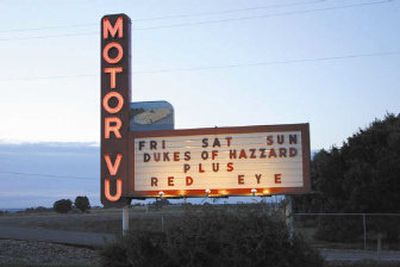Stars still come out at night at Vu

PARMA, Idaho – A piece of pop culture history lives on just off U.S. Highway 95 north of Parma.
Although the drive-in speakers are long gone, the atmosphere is still intact at the Parma Motor Vu, where the snack bar still features the original popcorn machine, red countertops and black and white linoleum floors and an admission price that can’t be beat.
Richard Hollingshead, an auto parts salesman in New Jersey, developed the first drive-in movie theater by putting a 1928 projector on the hood of his car, nailing a sheet between two trees and putting a radio behind that sheet for sound. Hollingshead eventually patented his “drive-in” concept in 1932.
During the drive-in theater’s heyday in the late 1950s, there were more than 4,000 open drive-ins across the nation and Canada. In the late 1950s, Idaho had 35 open drive-ins dotting the state. Now, only 11 remain open, according to statistics provided by Drive-ins.com.
The Parma Motor Vu has been providing drive-in entertainment since 1953, when Bill Dobbs built the 250-car theater in the fields outside Parma.
Now, the drive-in is owned and operated by his daughter, Karen Cornwell, who, with her husband, took over the business in 1976.
“I was the original popcorn girl and I was 15 years old. I was in the snack bar popping corn. That’s all I could do. My dad wouldn’t let me go out and sit in anybody’s car because he was out there and knew what was going on,” she laughed.
When Cornwell and her husband left Parma in 1960 headed for Lewiston, she didn’t see herself returning any time soon.
“We couldn’t get out of there fast enough,” she said.
Sixteen years later, they bought into the Motor-Vu and took over.
“I’ve loved it ever since,” Cornwell said.
The drive-in has seen a number of upgrades in Cornwell’s time – everything from replacing the old speakers with a new FM radio connection to the platter system used to project the movies.
Movies used to be shown using two projectors, which required the operator to switch projectors without interrupting the playing of the movie. Then came the big reels, which allowed for continuous play.
Cornwell made the switch to the big reels in 1982 but later upgraded in 1997 when her 40-year old projector died.
It was the year after her husband’s death and Cornwell was worried about being able to handle the drive-in alone and any repairs that might be necessary.
“I was so terrified of an equipment breakdown, because my husband could always fix things,” she said.
She purchased a new lamphouse for better lighting and the technician who installed the lamphouse offered her a “platter” system in exchange for her big reels.
Each “platter,” which is close to the size of an old wagon wheel, holds two movies, although the film still comes in the cans and the small reels and Cornwell has to transfer it to the platter.
The speaker system disappeared about 30 years ago, she said, when she decided to put in the radio system, which provides better sound and no maintenance, which in turn means saving money on repairs.
Drive-in enthusiasts and collectors of drive-in memorabilia, however, are willing to pay top dollar for the old speakers.
One of the biggest changes at the drive-in, Cornwell said, is her ability to play first-run movies just as soon as they hit the movie theaters.
Drive-in-goers no longer find themselves watching films that had come and gone at the local cinema.
“Now, I can get the most current movies as soon as there’s a print available. There’s no restrictions. We’re usually about three weeks out.”
Being the owner of the Linden 3 theater in Caldwell certainly helps too, and Cornwell said she just moves the films from the Linden 3 to the Motor Vu.
She said she doesn’t try to compete with the multiplexes that offer 10 screens or more of the newest movies.
Drive-ins appeal to people, she said, because of the low price, the comfortable atmosphere and for families, the ability to bring the kids along for a reasonable price.
“In previous decades, drive-ins were thought of as teen hangouts – one of the few places teens could be alone in those days. Today, drive-in owners are finding success by catering to families with movies like ‘Shrek,’ ‘Spy Kids’ and ‘Harry Potter,’ ” Jennifer Sherer, CEO of Drive-on-In Inc., said. “Drive-ins appeal to families with affordable concessions, double feature admission pricing and a ‘come as you are’ atmosphere.”
Despite the low admission price – just $5 for adults on Sunday and $6 for Friday and Saturday night shows – Cornwell said there is money to be made in the drive-in business during the busy months in the summer.
“It’s profitable, but it wouldn’t be much of a living for someone if that’s all they had, because it’s seasonal.”
Drive-ins closed, Cornwell said, not because they weren’t turning a profit, but because the land they were built on became too valuable for other uses.
The Parma Motor Vu, however, seems to be safe, for now, from impending development.
“We’re in the middle of all the farmland and no one is itching to drag all that gravel out of here,” she joked.
She said she plans to run the drive-in as long as she’s physically able, and also wants to preserve it for her grown children, who she hopes might someday want to take over the business.